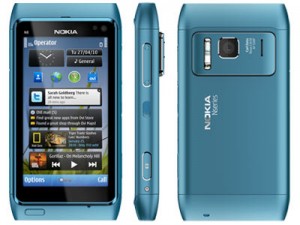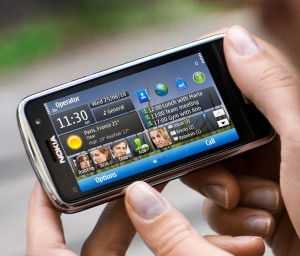On a day to day basis it’s easy to be overwhelmed by communication options. G-chat, cell phones, texts, e-mails, Skype, land-line phones (gasp!), even face-to-face conversations. When you’re going about your daily business all of this can be a bit much to deal with, but when facing the prospect of being abroad for an extended amount of time, options become very appealing. However, in many cases, more options implies more gear, which is not optimal for someone carrying everything they need on their back. My list of requirements for a device wasn’t the longest I could come up with, but it was long enough to cull most of the devices that are prevalent in our daily life. My MacBook can handle most of my communications needs, but it’s cumbersome and less than ideal for getting in touch with someone anywhere other than in a coffee house or internet café.
What I need
- Unlocked – I need to be able to swap sim cards out and take advantage of low(er) local rates and plans. Having a local number is a plus, and many plans allow free incoming calls.
- Durable – The phone has to be reliable and able to take at least a little beating.
- Good call quality/signal strength – Seems obvious.
- Discreet – This is a slightly dubious one. Any electronic device can be a target for theft. Preferably this phone is a little less apt to be stolen.
- At least quad band – A phone needs to be at least quad band to work on the various GSM networks around the world. Anything less (dual band phones are common on domestic carriers) and you may find yourself without a phone when you need one.
iPhone?
The iPhone seems like the obvious choice. It’s one of the most popular handsets in the country, and surely one of the most lusted after pieces of gear in the world, so why not an iPhone?
- Cost – An unlocked iPhone can easily run in excess of $600. That’s more money than I want to lay down for a phone, ever, and it stings all the more if it is damaged or stolen.
- Call Quality – iPhones aren’t exactly legendary for their call quality or signal strength. I know it’s improved with the last few generations, but that isn’t saying much.
- Access – Swapping the sim card isn’t the worst process in the world, as long as you have a paper clip and some patience.
- Durability – It’s made of glass. Seriously.
- Data – Nearly anything you want to do on an iPhone requires data. That can get expensive depending on where you are.
- Sync via iTunes – iTunes is kind of the worst. Think about it, you know it’s true.
The right phone
I ended up purchasing the N8, by Nokia. Considering Nokia’s (at the time) limited presence in the U.S., it may surprise some of you to learn that they are the biggest handset manufacturer in the world, and have a reputation for making extraordinarily good hardware. The biggest reason for my purchase was that the N8 is extremely well suited for travel. Here’s why:
- Unlocked – The N8 is factory unlocked. The sim card slot sits under a flap on the side of the phone, and is easily changed, no more removing the battery to get at the fidgety little card. Open the door, pop the old card out, pop the new one in, and done.
- Durable – The body of the phone is milled aluminum and the front glass is Gorilla Glass, which is essentially unbreakable.
- Call Quality – Calls come in loud and clear, all the time.
- Reception – The radio is penta (yes, five) band capable, meaning it will work on any network, anywhere. Also, the receiver in this phone is astonishing. I have three bars in our concrete bunker of a parking garage two stories underground. No other phone even tries to get on a network there.
- GPS – The N8 has a built-in GPS receiver that lets you navigate without a data connection and uses downloadable maps that can be updated free for life. You see, Nokia owns Navteq, the biggest mapmaker in the world, so I now have a complete map of nearly every country we are visiting sitting on my phone. No data connection required.
- Camera – A 12-megapixel camera with a real flash (no LEDs) and a Zeiss lens. I have never seen a file so good from a phone, it is better than my not so old Nikon point and shoot camera ever was. Also, it has a physical, two-stage camera button. Those of you who know what that means will know how nice that is.
- More – An OLED screen that is clear even in bright sunlight, Skype, WiFi, Swype, MS Office apps (free!), Exchange server support, fantastic battery life, a built-in FM transmitter and receiver (so you can play your music over your car radio) and the undeniably excellent hardware Nokia is renowned for. It even has Angry Birds, if you care for that sort of thing. And it comes in really cool colors.
Also!
We got Steph a Nokia C6-01. This is essentially an N8 “lite.” It’s still very robust, works great and is unlocked. It’s a little smaller, about half the price and the camera isn’t as good, but otherwise it’s very nearly the same phone. For those of you who are even more budget-minded, this is a very strong option, and we will be bringing it along as a back-up phone, just in case.
So…
Is it the fastest, bestest phone evaaarr? Not likely. I am certain that if you benchmarked it, it wouldn’t do terribly well. Is it running Android or iOS or Windows phone? No, it runs Symbian Belle, a quirky OS that is actually quite good, but obscure. But, let’s get real for a moment, shall we? This phone may be a little over two years old, but it does everything I need it to do, rather well in fact. In the age of new handsets every three months with more cores and more RAM and more resolution, it’s easy to lose perspective of what we need our phones to do, and just how fast we really need them to be. My little phone will hang for a millisecond or two sometimes when I switch home screens. Sometimes it takes a moment to pull up my contacts, or open an app. How much time have I lost to these annoyances? Maybe a minute in the year I have owned the phone. Is it important? Not at all. This phone works like a champ and does everything I need it to do. For the money, it’s a steal.
I’m really excited to put the N8 through its paces once we are overseas, and will most definitely keep you all up-to-date on any and all impressions as time goes by. I expect this phone to do swimmingly, but (as always) time will tell.


Tony, this is such a helpful post!! I have an iPhone that looks like it’s coming to Honduras with me and I’m a little nervous about it (given my klutzy track record, and the break & enter stats for where I’m going). I guess I need to get it unlocked to use it there… I’m not too good with the technical stuff. At least knowing I’m in one spot makes things a bit easier – I think a lot of people where I’m going just use their iPhones as mini-computers and buy a cheap local cell which is what I’ll probably end up doing. However, I am planning to travel afterwards, and I have been wondering what other travellers were using so this was really useful. I like the sounds of that Gorilla Glass!
Yeah, you would have to get your iPhone unlocked to use it with other carriers, assuming your phone is a model that uses a sim card. Here in the US there are a couple of carriers that are HSPA (or whatever the acronym is) meaning they don’t use a sim card and won’t work off the carrier’s network, no matter what you do. Pretty much if you want to use your phone on something other than your carrier’s roaming plan it has to be unlocked.
I love my iphone, but if I were to plan a trip like the one you are undertaking, I would seriously consider another device. It just doesn’t have the right signal strength all the time, and it’s also expensive. I like that you did your homework with this one and that you chose something that will fit your needs.
Thanks! We’re definitely an apple household here, so the iPhone certainly holds some temptation for us, but ultimately it’s just not really well-suited to travel. I am sure we would end up loving an iPhone just like evveryone else who owns one, but it seems like effective travel with an iPhone requires more compromisesa than other options.
Great post! Very helpful. For our trip we haven’t even thought about what to do about a phone but it’s definitely important to bring a good one. Am very impressed with the GPS features — that you have access to maps without a data connection – that’s awesome! Will be interesting to read how this phone works out for you!
While it’s not exactly the ends of the earth, we’ve been using Tony’s phone very successfully sans data plan while up here in Canada. Had no problem getting SIM card so that we can have a local number, and the GPS navigation has worked a treat. I have a feeling the real test will be Asia, but hey, baby steps!
I’d agree with you on keeping the phone low key to minimize the risk of theft. I almost bought a Samsung G3, but after seeing that the sim card is different I held off because I wasn’t sure if I would be able to purchase one to work with the phone.
Probably a good call. I honestly haven’t seen anything other than the regular cards since we have been traveling. Pretty much everyone we see is using a cheap Nokia of some sort, though there are a few Samsungs out there. The N8 has been a champ on the prepaid front, no issues at all.
Still loving your Nokia N8? How ’bout an update review? would love your thoughts now that you’ve used it for awhile…
You are right about our generation having given a great number of communication options since gadgets and smartphones have been a constant gadget for us and picking what device that is perfect for us can be tricky. This article is very helpful in deciding what kind of phone to pick.
What an interesting read! It’s great you found a phone with everything on your checklist! It seems discreet enough and has excellent reception compared to other smartphones.